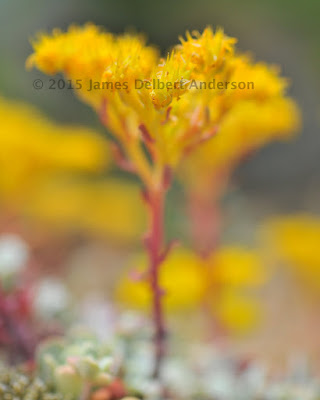For a bit of a change of pace from last week's wilderness adventures, I headed this time for two island destinations - Ebey's Landing on Whidbey Island and Deception Pass State Park on Fidalgo Island. The weather was great for photography - not too breezy, and overcast but still bright. Occasionally the sun would intrude, but the weather stayed remarkably consistent for most of the day. It had been a while since I'd visited Ebey's Landing, and I wanted to give it another try. Moreover, I'd never been to Deception Pass in late May - I usually go in mid- or late April - so I wanted to see what I could find there as well.
We'll begin with the photographs from Ebey's Landing. First is a closeup of fiddleneck (genus
Amsinckia). The WNPS plant list for Ebey's Landing lists four varieties of
Amsinckia in the area and I am not sure which this is. In any case, I used f/3.8 to maximize the selective focus effect.
Second, we have fool's onion (
Brodiaea hyacinthina). I stopped down to f/5.6 to get a bit more of the flowers in focus than the widest setting would have provided.
Below is a small lupine bloom, at f/7.1 to get a bit more form in the background leaves and flower. I think it's one of my better lupine closeups to date.
Last, not quite as close up, is what looks like a variety of geranium, with the fields of the historic reserve area in the background. I used f/8 to get a bit more definition in those fields and make the color bands come through.
Next, we'll transition to some more landscape-ish shots from Ebey's Landing. This one looks more or less northwest from one of the trailheads; the flowers in the foreground are again what looks like some sort of geranium (or perhaps a couple different varieties, if the pink and white aren't variants of the same species). I used f/18 to get everything in focus, including the distant beaches in the background.
Below is an image from the farthest point along the trail, looking roughly southeast with yarrow and vetch in the foreground and Perego's Lagoon in the background. F/25 to get everything in focus.
On a little side trail (it was overgrown but had definitely been cut as a trail; I wasn't trampling the meadows, I swear), I found this clump of lupine whose flowers had some interesting yellow and red coloration. They might be tree lupine (
Lupinus arboreus); that's the only lupine with yellow flowers on the WNPS list. This photo sets them against the beaches and Perego's Lagoon down below. F/29.
Finally, a wild rose, also with the beaches and lagoon in the background. I tried this first with a narrow aperture but thought this one worked better with a wider setting (F/6.3). I think this did a better job of accentuating the flowers themselves.
Now on to Deception Pass State Park, specifically the Lighthouse Point trail, where all of the pictures that turned out well were closeups.
First is nodding onion (
Allium cernuum). I stopped down just a bit to f/5 to get a slightly more substantial area of the flower in focus.
Next, another member of the onion family, Hooker's onion (
Allium acuminatum). F/5, similarly to the last one.
The next one looks like it might be in the clover or pea family, but I don't have a good ID on it yet. F/5.
Finally, two images of broad-leaved stonecrop (
Sedum spathulifolium). I'd seen these flowers budding here before, and it being later in the spring this time, I headed back to where I had seen them to photograph them blooming. I set my small tripod all the way on the ground to put the flowers at eye level; in the past, I've photographed stonecrop top-down. For selective focus, I also used the widest aperture I could - f/3.3 in both cases.



















































